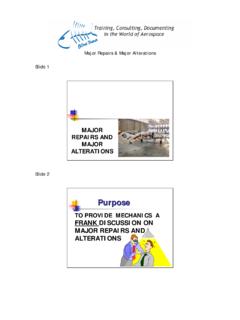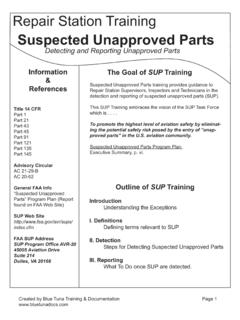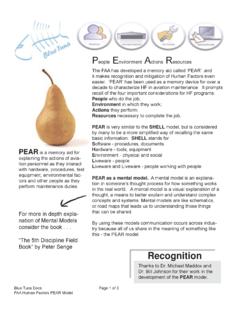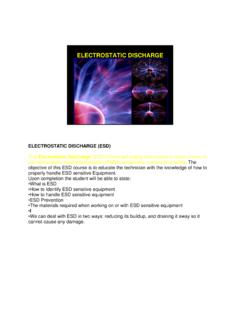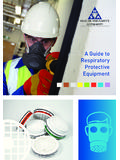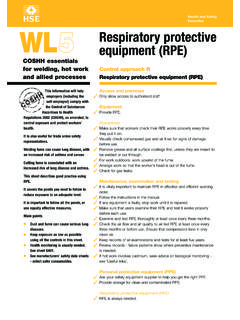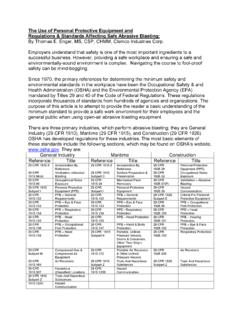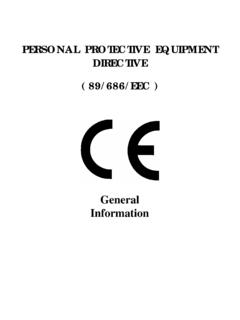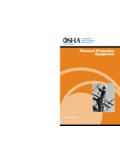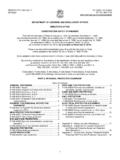Transcription of Personal Protective Equipment - BlueTuna
1 1 Personal ProtectiveEquipmentHazard Assessment and SelectionSlide Show Notes Welcome to the training session about Protective clothing. Thissession is designed for supervisors and facility managers to helpyou conduct hazard assessments and to select the appropriatepersonal Protective Equipment (PPE) for your employees on thebasis of the hazard Business & Legal Reports, ObjectivesYou will be able to: Understand the PPE hazard assessmentprocess Select appropriate PPE for the job Show employees how to properly wear andcare for PPES lide Show NotesBy the end of the training session, you will be able to: Understand how a PPE hazard assessment is conducted, whichinvolves evaluating the workplace and job functions for anypotential hazards that can be controlled through the use of PPE.
2 Select the proper PPE to protect against the hazards found duringthe hazard assessment. Show employees how to properly wear and care for their Business & Legal Reports, Assessment Evaluate every jobfunction in everydepartment Determine if hazardsare present Check for hazards toeyes, respiratorysystem, head, feet,hands Determine what PPEwill protect againsthazardsSlide Show NotesBefore you can select PPE, you must know what hazards youremployees may be exposed to. Information about hazards is collectedthrough a hazard assessment. Here s an overview of how theassessment is conducted: Evaluate every job function in every department for potentialhazards. The purpose of a hazard assessment is to evaluate the workplaceand job functions to see if employees are exposed, or potentiallyexposed, to hazards that might cause injury.
3 A simple checklist canbe used to determine if hazards are present. The checklist will cover hazards to the eyes, respiratory system,head, feet, and hands. Next, determine what type of PPE will protect against the specifichazards found. For example, determine if safety glasses areadequate or whether the worker will need a simple checklist that includes the items listed on thefollowing slides for each part of the body. Use the checklist to evaluateeach job to determine if potential hazards are Business & Legal Reports, and Face Assessment Flying particles Molten metal Liquid chemicalsSlide Show NotesHazard assessments are conducted to protect each part of the ll start with the eyes and face.
4 Evaluate the workplace to determine if employees are exposed toflying particles such as dusts from grinding, metal chips frommachine shop Equipment , and wood chips from a cabinet particles cause the majority of eye-related injuries. Determine if your employees are exposed to any molten metal thatmight splash up and damage the eyes or burn the face. Liquid chemicals are also a very common eye and face cans, cleaning solutions, solvents for cleaning metal parts,and spray adhesives or paints are all examples of liquid chemicalsthat might be sprayed or splashed on a worker s face or Business & Legal Reports, and Face Assessment(cont.) Acid or caustic liquids Chemical gases or vapors Potentially injurious light radiationSlide Show Notes Acid and caustic liquids are especially dangerous because of theextreme damage they can do to the eyes and face.
5 Acids are oftenused for etching metals, and caustic liquids are used in a number ofcleaning processes. Battery acid from electric forklifts is anothercommon eye hazard. Chemical gases and vapors can also damage the eyes. Propane,used to power many forklifts, is very cold and could cause severeeye damage. Vapors or gases can cause eye redness or irritation. Potentially injurious light radiation refers to the bright light duringwelding and cutting operations as well as laser operations. Eyescan be severely damaged when an employee looks directly intowelding or laser this slide to describe the specific hazards in your trainees to think of other potential eye and face hazards specific tothe workplace that are not listed on this Business & Legal Reports, ProtectionHazard AssessmentAssess the workplace: Inhalation of airbornedusts or particulates Inhalation of chemicalvapors or fumes Lack of adequateoxygenSlide Show NotesFor respiratory hazards, assess the workplace for the followingconditions.
6 Evaluate the workplace for the potential inhalation of airbornedusts or particulates. These dusts might be from grinding, cutting,sanding, or welding operations. Other dusts are from grains, woodchips, or other solid granular materials. Assess for chemical vapors or fumes, which can come from anytype of chemical handling operations. Using solvents, sprayingwith aerosol cans, painting operations, bulk loading or unloadingof chemicals, and handling drums of chemicals are just a fewexamples of jobs that could result in inhalation of chemical vaporsor fumes. Lack of oxygen typically refers to jobs that require confined spaceentry in which there may be insufficient oxygen for a worker toenter without respiratory are the primary types and causes of respiratory injuries.
7 Can youthink of any other potential respiratory hazards specific to yourworkplace that are not listed on this slide?Modify or delete this slide and the next slide as they apply or do notapply to your Business & Legal Reports, ProtectionHazard Assessment (cont.) Identify the specific source(s) of respiratoryhazard Review the work processes to determine thehazard source and magnitude Monitor the exposureSlide Show NotesOnce the assessment has identified the potential for exposure to dusts,chemical vapors, or a lack of oxygen, it must go deeper and include: Identification of the hazardous substance(s) that may be the sourceof the respiratory hazard(s). Review of work processes to determine where hazardousexposures occur as well as the magnitude of the exposure(s).
8 Exposure monitoring to measure potential hazardous or delete this slide as it applies to your Business & Legal Reports, Hazard Assessment Falling objects Exposed electricalconductors Low-hangingobstructionsSlide Show Notes Determine if the job exposes workers to objects that couldpotentially fall from above. If employees work in an area whereother workers are above them on catwalks or mezzanines, there ispotential for falling objects. If employees are potentially exposed to electrical conductors, theyneed to protect their heads with appropriate hard hats. Low-hanging obstructions present another head hazard as whenan employee needs to walk or crawl under Equipment for cleaningor are the primary causes of head injuries.
9 Can you think of anyother potential head hazards specific to your workplace that are notlisted on this slide?90507 Business & Legal Reports, Hazard Assessment Falling, rolling, orsharp objects Electrical hazards Slippery walkingsurfaces Hazardous chemicals Cold weatherconditionsSlide Show Notes Employees who handle heavy metal parts or tools mightaccidentally drop a heavy object on their foot. Some workplacesexpose employees to heavy rolling objects such as large rolls ofpaper and forklift tires. Both falling objects and rolling objectscould crush a worker s foot. Some workplaces expose workers toobjects that might pierce the sole of their shoe and foot. Employees working with or around electrical systems orequipment need to wear well-insulated, nonmetal footwear.
10 Slippery walking surfaces may result in falls. Although the injuryis not likely to occur to the foot itself, it is still considered a foothazard because better footwear could prevent that type of incident. Employees who work with hazardous chemicals may be subject tosplashing or other events that could result in hazardous chemicalscontacting the feet. Employees who are working in cold weather conditions need toprotect your feet from the obvious hazard of are the primary types and causes of foot injuries. Can you thinkof any other potential foot hazards specific to your workplace that arenot listed on this slide?100507 Business & Legal Reports, Hazard Assessment Skin absorption ofharmful substances Severe cuts orlacerations Severe abrasionsSlide Show Notes Evaluate the workplace to determine if employees hands areexposed to harmful substances that might be absorbed through ordamage the skin.

